2012 Peugeot 3008 Hybrid 4 cruise control
[x] Cancel search: cruise controlPage 5 of 284

CONTENTS
ALPHABETICALINDEX 271-274
DRIVING 143-162
CHECK
S 163-169
PRACTICAL
INFORMATION 170-199
TECHNICAL DATA 200-204
AUDIO EQUIPMENTand TELEMATICS 205-270
Electric parking brake...................143Hill start assist..............................148Head-up display...........................151Speed limiter................................r153Cruise control...............................1556-speed electronic gear control gearbox......................................157Parking sensors ............................161
Bonnet..........................................164Running out of fuel (Diesel)..........165Diesel engine................................166Checking levels............................167Checks..........................................168
Temporary puncture repair kit......170Changing a wheel.........................176Changing a bulb...........................179Changing a fuse ...........................18312 V Battery..................................190Energy economy mode................193Changing a wiper blade...............194Recovering the vehicle.................194Vehicle recovery ...........................195Towing a trailer.............................r196Fitting roof bars............................197Very cold climate screen..............197Accessories..................................198
Electric motor...............................r200Diesel engine................................201Diesel weights ..............................202Dimensions ...................................203Identification markings..................204
VISUAL SEARCH 275-279
Emergency or assistance.............205Peugeot Connect Media Navigation(NG4 3D)....................................209Peugeot Connect Sound (RD5)....253
Page 10 of 284

8
FA
M
FOR ECONOMICAL DRIVING, CARING FOR THE ENVIRONMENT
Main recommendations for driving economically
Gear lever
Use the automatic
mode A
as much
as possible as this optimises gear
changes to suit the requirements.
The fuel consumption
of a vehicle varies greatly
:
- according to the driver's style of driving
(moderate, aggressive, fast, ...),
- according to the type of journeys
made (urban, main road, motorway, fl ow-
ing, heavy traffi c, …) and the speed.
Hybrid mode selector
To optimise fuel consumption, use the
Auto
mode
of the selector whenever
possible (the mode is activated auto-
matically when starting) including for
urban journeys.
This mode optimises the use of the ener-
gy sources (internal combustion engine
and/or electric) contrary to other modes,
which are for use in particular cases.
Stay in the "eco" zone
displayed in the
energy consumption / generation indi-
cator: accelerate gently, drive at steady
speeds using the speed limiter or cruise
control as soon as possible.
Causes of high consumption and
checks
As with any vehicle, limit overloading,
wind resistance (windows open above
30 mph (50 km/h), roof rack, loaded or
not, …), the use of power consumers
(air conditioning, heated seats, heated
rear screen, …).
Observe the recommendations on
checks (regular check of tyre pres-
sures, correct tyre pressures, …) and
routine servicing.
Consumption history
See the impact of your style of driving
and the type of journey by reviewing
the history of your energy consumption.
Refer to the "Multifunction screens"
section.
Use the "charge"
zone: anticipate the
need to slow down by taking your foot
off the accelerator rather than braking.
The movement of the energy consump-
tion / generation indicator needle (into
the "charge" zone), shows the level of
energy recovery.
Drive smoothly
Page 14 of 284
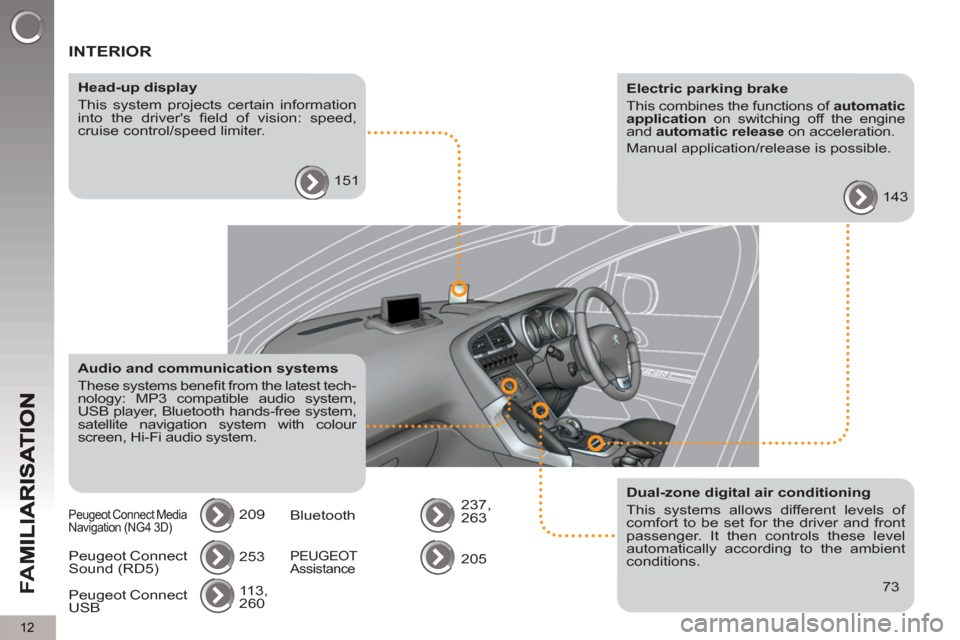
12
FA
M
INTERIOR
Electric parking brake
This combines the functions of automatic
application
on switching off the engine
and automatic release
on acceleration.
Manual application/release is possible.
143
Audio and communication systems
These systems benefi t from the latest tech-
nology: MP3 compatible audio system,
USB player, Bluetooth hands-free system,
satellite navigation system with colour
screen, Hi-Fi audio system.
209
Dual-zone digital air conditioning
This systems allows different levels of
comfort to be set for the driver and front
passenger. It then controls these level
automatically according to the ambient
conditions.
73 Peugeot Connect
Sound (RD5) 253
113,
260 Peugeot Connect
USB
Peugeot Connect Media
Navigation (NG4 3D) Bluetooth 237,
263
PEUGEOT
Assistance 205
Head-up display
This system projects certain information
into the driver's fi eld of vision: speed,
cruise control/speed limiter.
151
Page 15 of 284
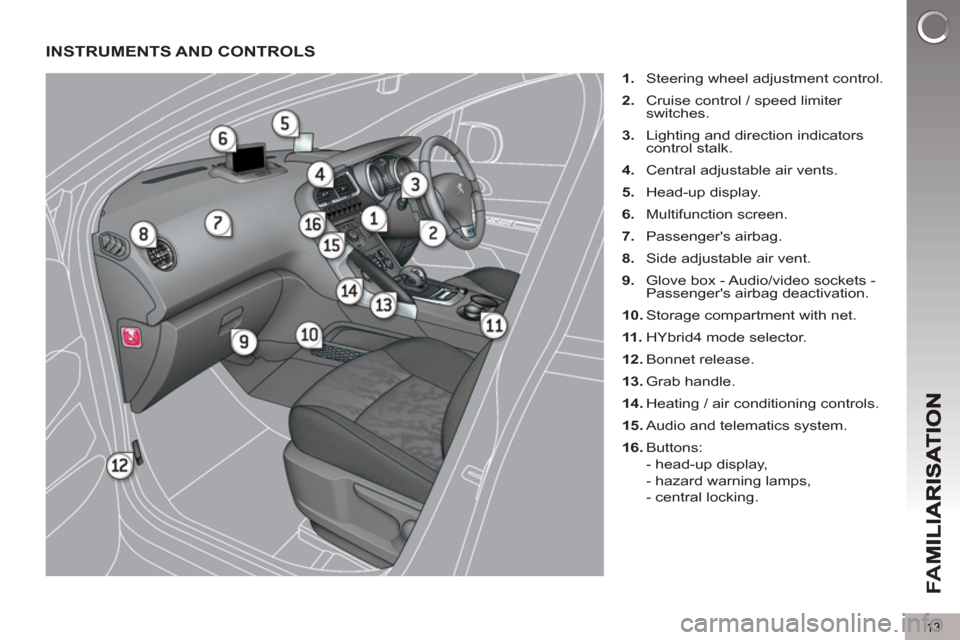
13
FA
M
INSTRUMENTS AND CONTROLS
1.
Steering wheel adjustment control.
2.
Cruise control / speed limiter
switches.
3.
Lighting and direction indicators
control stalk.
4.
Central adjustable air vents.
5.
Head-up display.
6.
Multifunction screen.
7.
Passenger's airbag.
8.
Side adjustable air vent.
9.
Glove box - Audio/video sockets -
Passenger's airbag deactivation.
10.
Storage compartment with net.
11 .
HYbrid4 mode selector.
12.
Bonnet release.
13.
Grab handle.
14.
Heating / air conditioning controls.
15.
Audio and telematics system.
16.
Buttons:
- head-up display,
- hazard warning lamps,
- central locking.
Page 26 of 284
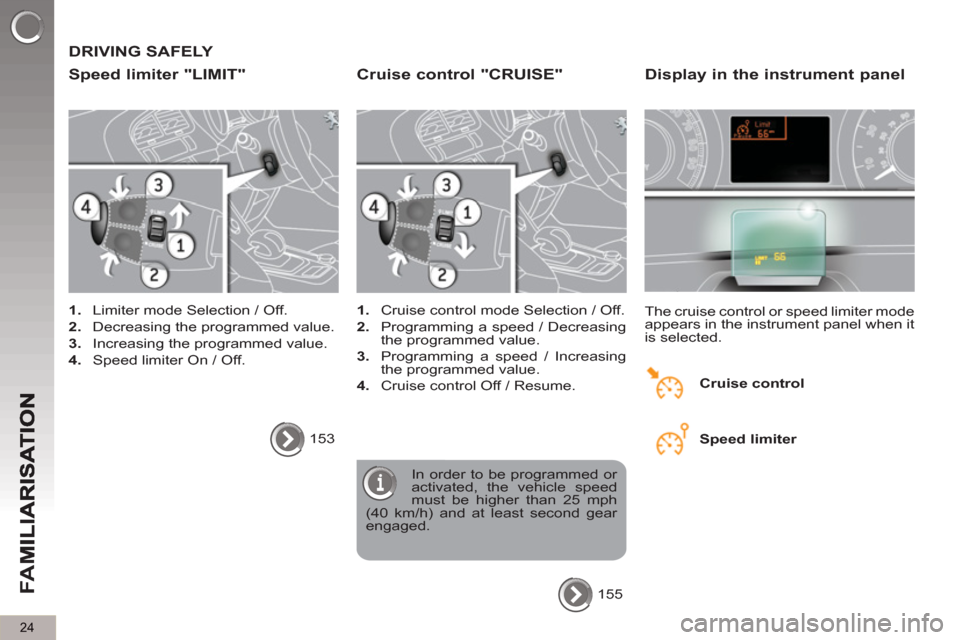
24
FA
M
DRIVING SAFELY
S
peed limiter "LIMIT"
1.
Limiter mode Selection / Off.
2.
Decreasing the programmed value.
3.
Increasing the programmed value.
4.
Speed limiter On / Off.
153
Cruise control "CRUISE"
1.
Cruise control mode Selection / Off.
2.
Programming a speed / Decreasing
the programmed value.
3.
Programming a speed / Increasing
the programmed value.
4.
Cruise control Off / Resume.
In order to be programmed or
activated, the vehicle speed
must be higher than 25 mph
(40 km/h) and at least second gear
engaged.
155
Display in the instrument panel
The cruise control or speed limiter mode
appears in the instrument panel when it
is selected.
Cruise control
Speed limiter
Page 41 of 284
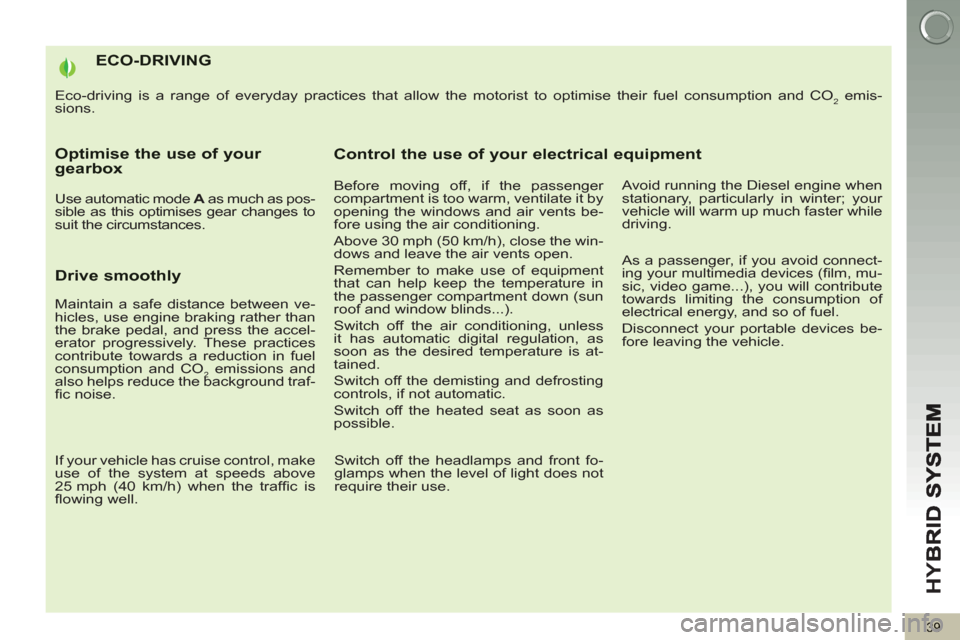
HY
B
39
ECO-DRIVING
Eco-driving is a range of everyday practices that allow the motorist to optimise their fuel consumption and CO2 emis-
sions.
Optimise the use of your gearbox
Use automatic mode A
as much as pos-
sible as this optimises gear changes to
suit the circumstances.
Drive smoothly
If your vehicle has cruise control, make
use of the system at speeds above
25 mph (40 km/h) when the traffi c is
fl owing well.
Control the use of your electrical equipment
Before moving off, if the passenger
compartment is too warm, ventilate it by
opening the windows and air vents be-
fore using the air conditioning.
Above 30 mph (50 km/h), close the win-
dows and leave the air vents open.
Remember to make use of equipment
that can help keep the temperature in
the passenger compartment down (sun
roof and window blinds...).
Switch off the air conditioning, unless
it has automatic digital regulation, as
soon as the desired temperature is at-
tained.
Switch off the demisting and defrosting
controls, if not automatic.
Switch off the heated seat as soon as
possible.
Switch off the headlamps and front fo-
glamps when the level of light does not
require their use.
Avoid running the Diesel engine when
stationary, particularly in winter; your
vehicle will warm up much faster while
driving.
As a passenger, if you avoid connect-
ing your multimedia devices (fi lm, mu-
sic, video game...), you will contribute
towards limiting the consumption of
electrical energy, and so of fuel.
Disconnect your portable devices be-
fore leaving the vehicle.
Maintain a safe distance between ve-
hicles, use engine braking rather than
the brake pedal, and press the accel-
erator progressively. These practices
contribute towards a reduction in fuel
consumption and CO
2 emissions and
also helps reduce the background traf-
fi c noise.
Page 49 of 284
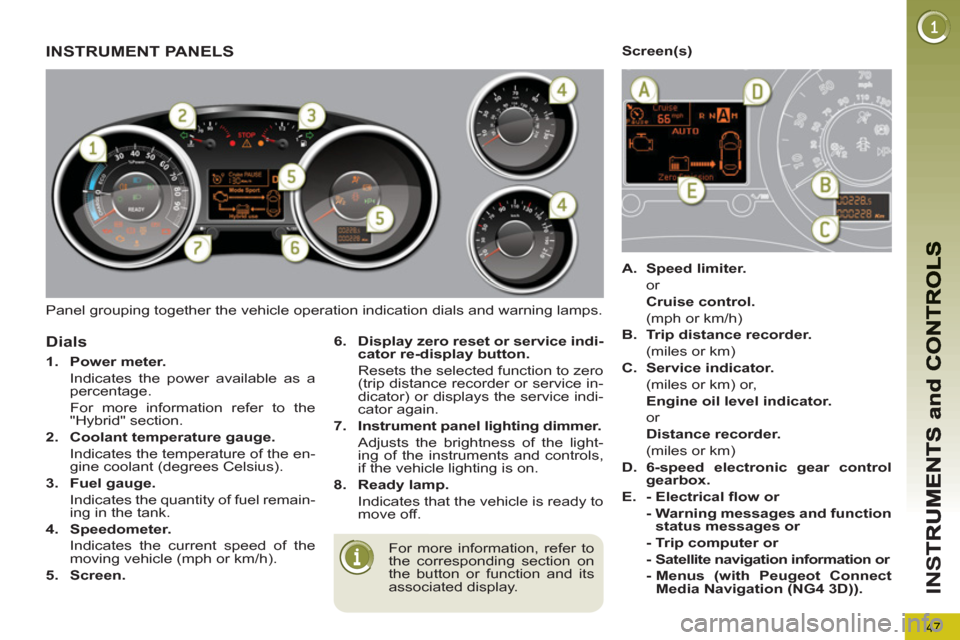
47
IN
S
Panel grouping together the vehicle operation indication dials and warning lamps.
INSTRUMENT PANELS
For more information, refer to
the corresponding section on
the button or function and its
associated display.
Dials
6.
Display zero reset or service indi-
cator re-display button.
Resets the selected function to zero
(trip distance recorder or service in-
dicator) or displays the service indi-
cator again.
7.
Instrument panel lighting dimmer.
Adjusts the brightness of the light-
ing of the instruments and controls,
if the vehicle lighting is on.
8.
Ready lamp.
Indicates that the vehicle is ready to
move off.
1.
Power meter.
Indicates the power available as a
percentage .
For more information refer to the
"Hybrid" section.
2.
Coolant temperature gauge.
Indicates the temperature of the en-
gine coolant (degrees Celsius).
3.
Fuel gauge.
Indicates the quantity of fuel remain-
ing in the tank.
4.
Speedometer.
Indicates the current speed of the
moving vehicle (mph or km/h).
5.
Screen.
Screen(s)
A.
Speed limiter.
or
Cruise control.
(mph or km/h)
B.
Trip distance recorder.
(miles or km)
C.
Service indicator.
(miles or km) or,
Engine oil level indicator.
or
Distance recorder.
(miles or km)
D.
6-speed electronic gear control
gearbox.
E.
- Electrical fl ow or
- Warning messages and function
status messages
or
- Trip computer or
- Satellite navigation information or
- Menus (with Peugeot Connect
Media Navigation (NG4 3D)).
Page 116 of 284
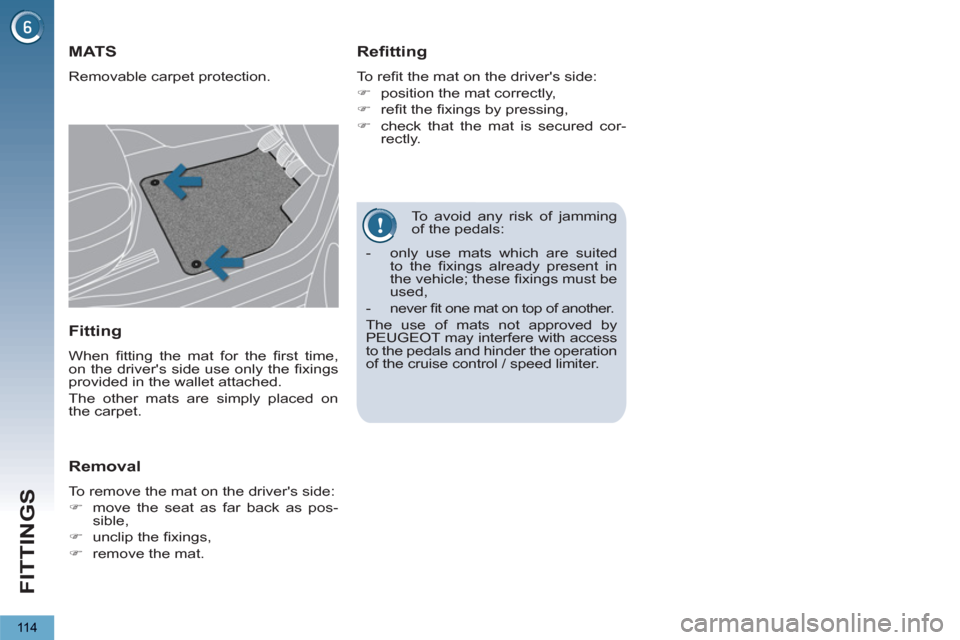
FITTINGS
11 4
To avoid any risk of jamming
of the pedals:
MATS
Removable carpet protection.
Refitting
To refi t the mat on the driver's side:
�)
position the mat correctly,
�)
refi t the fi xings by pressing,
�)
check that the mat is secured cor-
rectly.
Fitting
When fi tting the mat for the fi rst time,
on the driver's side use only the fi xings
provided in the wallet attached.
The other mats are simply placed on
the carpet.
Removal
To remove the mat on the driver's side:
�)
move the seat as far back as pos-
sible,
�)
unclip the fi xings,
�)
remove the mat.
- only use mats which are suited
to the fi xings already present in
the vehicle; these fi xings must be
used,
- never fi t one mat on top of another.
The use of mats not approved by
PEUGEOT may interfere with access
to the pedals and hinder the operation
of the cruise control / speed limiter.